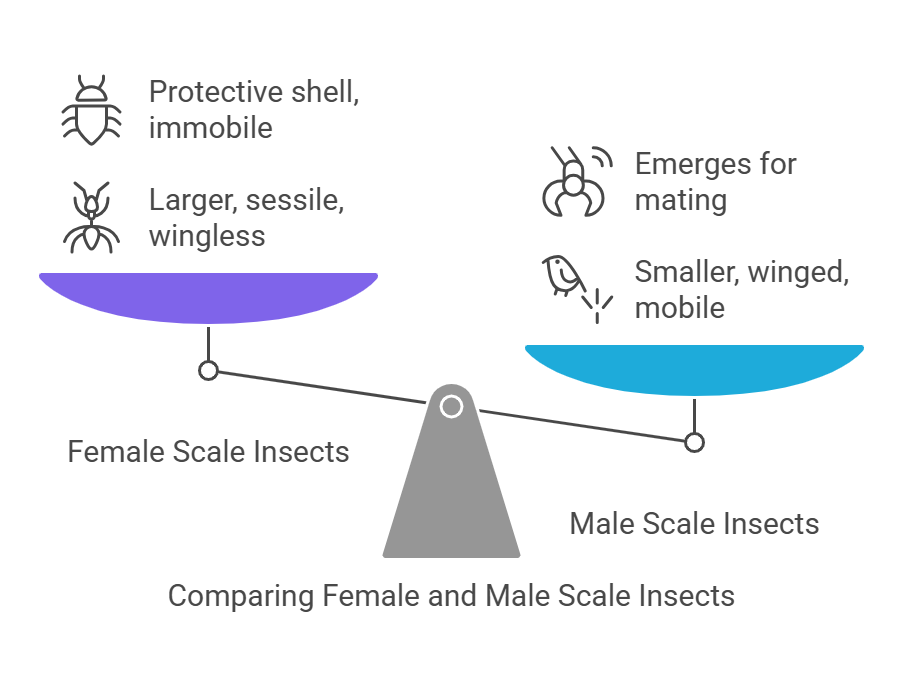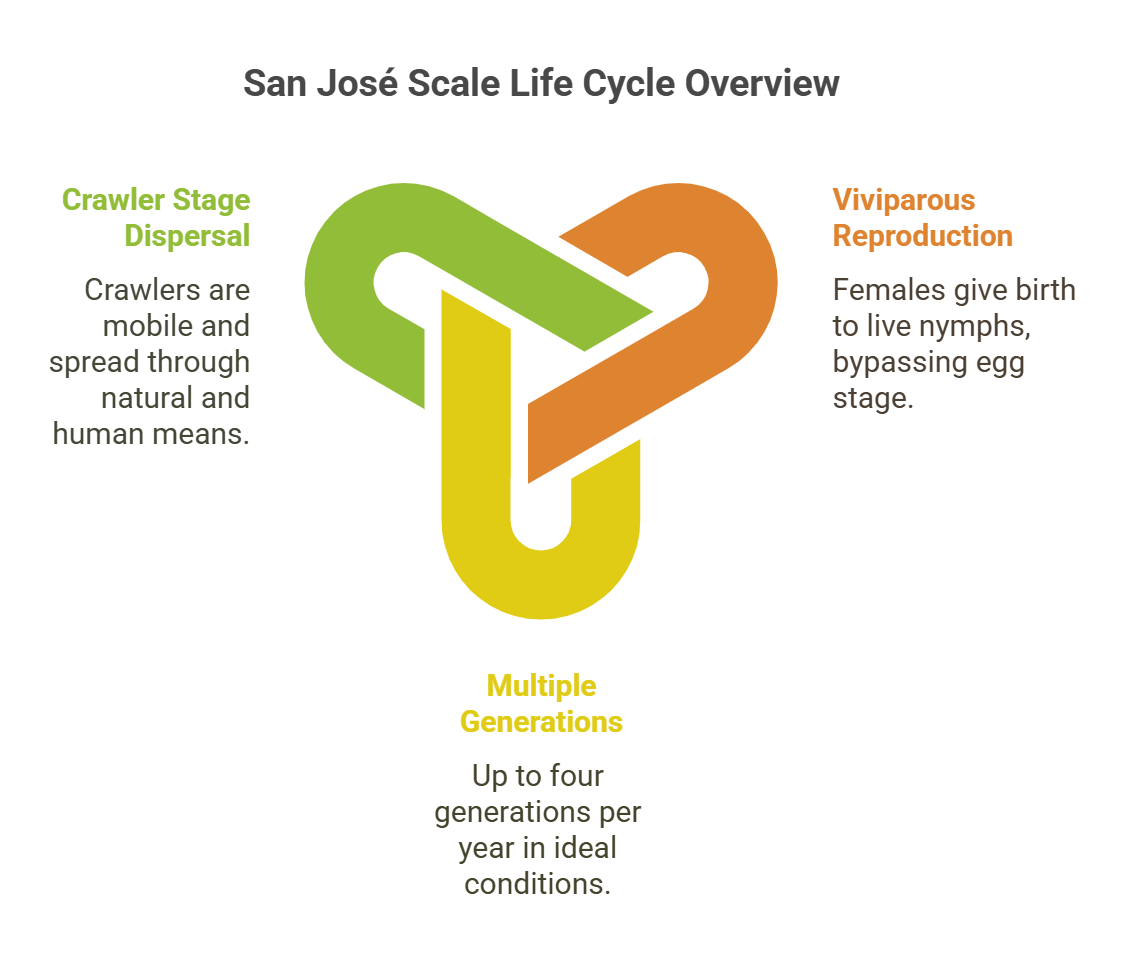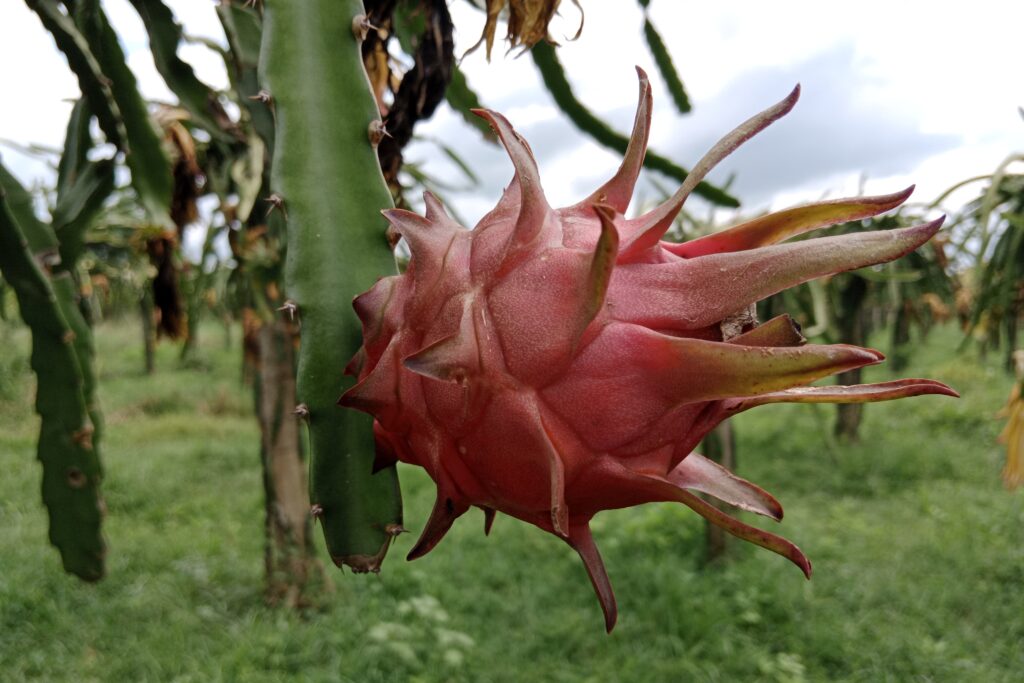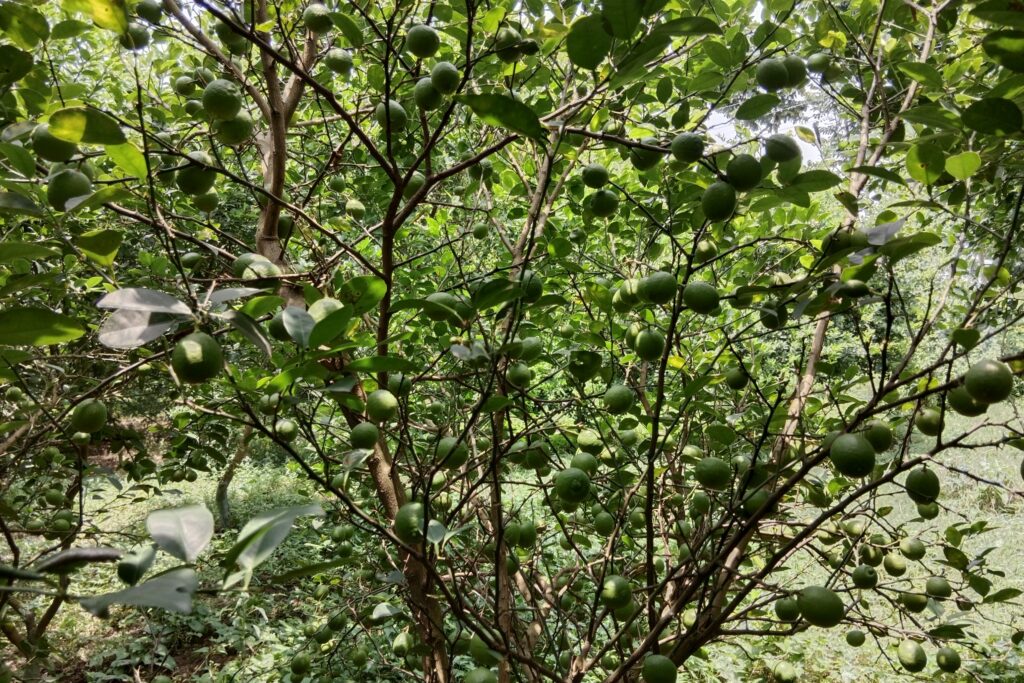San Jose Scale
The San Jose scale (Quadraspidiotus perniciosus) is a highly invasive and destructive armored scale insect from the family Diaspididae, notorious for its detrimental impact on agriculture and horticulture. Native to Asia, this pest has successfully expanded its range to warmer regions across the globe due to international trade and its remarkable adaptability to diverse climates.
Known for its polyphagous feeding habits, it infests a wide variety of plants, including fruit trees, ornamental shrubs, and woody plants, with a preference for economically important crops such as apples, pears, and peaches. The pest’s high reproductive potential, coupled with its ability to develop resistance to chemical controls, enables it to establish and thrive rapidly in new environments. If left unmanaged, infestations can lead to severe consequences, including reduced crop yields, tree dieback, and eventual plant death, making the San José scale a persistent and formidable challenge for growers and agricultural systems worldwide.
Morphological Characteristics

Size & Appearance
- Adult females have a circular, flat, grayish-black protective scale covering with a distinct yellowish central spot.
- Adult scales measure approximately 1.5–2.0 mm in diameter.
- Males are smaller, winged, and capable of flight, while females remain sessile (immobile) beneath their protective scale.
Development Stages
- Eggs hatch into crawler-stage nymphs, which are yellow and mobile, dispersing to find feeding sites.
- As they mature, they secrete a waxy protective shell, becoming resistant to external threats.
- Adult females remain under the protective covering, while adult males emerge for mating.
Also Read About: Soft Scale Insects.
Life Cycle & Reproductive Potential

Viviparous Reproduction
The San Jose scale (Q. perniciosus) exhibits viviparous reproduction, a unique feature compared to many other scale insects that lay eggs. Females give birth to live, active nymphs, also known as “crawlers,” which bypass the egg stage entirely. This mode of reproduction allows for faster population growth, as there is no delay in the life cycle caused by egg incubation. As a result, populations of Q. perniciosus can expand at an alarming rate, particularly in regions with favorable conditions.
Multiple Generations Per Year
One of the most significant factors contributing to the pest’s destructive potential is its ability to produce multiple generations annually. In warmer climates, where environmental conditions are ideal, up to four overlapping generations can occur within a single year. Each generation contributes to a cumulative population boom, leading to heavy infestations that can quickly overwhelm host plants. In cooler regions, the number of generations may be reduced, but the pest remains a persistent threat due to its adaptability and survival strategies.
Crawler Stage Dispersal
The crawler stage, which is the first instar nymph stage, is the most mobile and vulnerable phase of the San Jose scale’s life cycle. Crawlers are actively involved in dispersal and represent the primary target for chemical control measures, as they lack the protective armor that characterizes later developmental stages. During this phase, crawlers can spread through various means, including natural factors such as wind, birds, and other insects. Human activities, such as the movement of infested plant material, also play a significant role in their rapid establishment in new areas. This dispersal capability enables the pest to colonize distant locations, contributing to its invasive potential and widespread distribution.
Host Range and Agricultural Impact
Highly Polyphagous
San Jose scale attacks over 200 species of trees and shrubs, including fruit trees, ornamentals, and forest species.
Primary Host Plants
- Pome fruits (e.g., apple, pear, quince)
- Stone fruits (e.g., peach, plum, cherry, apricot)
- Nut trees (e.g., walnut, almond)
- Ornamentals and shrubs (e.g., rose, poplar, willow, maple, lilac)
Damage Symptoms
- Sap Removal & Tree Weakening: Both nymphs and adults feed by piercing plant tissues and sucking sap, depleting essential nutrients and moisture.
- Yellowing, Premature Leaf Drop, and Dieback: Infested branches turn yellow, weaken, and eventually die.
- Fruit Damage: Fruits develop reddish or purple spots around feeding sites, reducing market value and yield.
- Severe Infestations Lead to Plant Death: Uncontrolled populations cause progressive dieback, eventually killing entire trees over time.
Management and Control Strategies
Effective control of the San Jose scale (Q. perniciosus) is challenging due to the hard protective covering of adult scales, which renders them resistant to many traditional chemical treatments. As such, a comprehensive Integrated Pest Management (IPM) approach is essential. This strategy integrates biological, cultural, and chemical methods to suppress scale populations while minimizing environmental impact and fostering long-term pest control.
Biological Control
Biological control relies on the natural regulation of San José scale populations by predators and parasitoids. These beneficial organisms play a vital role in sustainable pest management:
Natural Enemies
- Parasitic wasps such as Aphytis diaspidis and Encarsia perniciosi effectively parasitize scale nymphs, reducing population densities.
- Predatory beetles like Chilocorus kuwanae and other members of the family Coccinellidae feed on scale insects, including both nymphs and adults.
Encouraging Beneficial Insects
- To enhance the effectiveness of natural enemies, it is crucial to avoid the use of broad-spectrum insecticides that harm both pests and beneficial insects.
- Providing flowering plants and undisturbed habitats near orchards can attract and sustain predator and parasitoid populations.
Cultural Control
Cultural practices aim to prevent infestations and reduce pest numbers by modifying the growing environment and employing proactive measures:
Monitoring & Early Detection
Regular inspections of host plants, particularly near leaf midribs, branch junctions, and sheltered areas, help detect early infestations. Pheromone traps and sticky cards can also be used to monitor crawler activity.
Pruning Infested Branches
Severely infested branches should be pruned and destroyed to remove scale colonies and limit further spread. Proper sanitation of tools prevents contamination of healthy plants.
Controlling Ants
Ants often form mutualistic relationships with scale insects, protecting them from natural enemies in exchange for honeydew. Managing ant populations using baits or barriers improves the efficiency of biological control agents.
Chemical Control
Chemical control remains a critical tool, particularly during heavy infestations, but its success depends on the appropriate selection and timing of treatments:
Dormant Oil Sprays
Horticultural oils applied during late winter or early spring are highly effective in suffocating overwintering scales. These oils penetrate protective coverings, making them ideal for non-toxic, broad-spectrum control.
Insect Growth Regulators (IGRs)
Compounds like pyriproxyfen and buprofezin disrupt the development of scale nymphs, preventing them from reaching maturity. These targeted treatments are safer for non-target organisms compared to traditional insecticides.
Systemic Insecticides
Neonicotinoids, such as imidacloprid and thiamethoxam, are effective when applied during the crawler emergence period. These systemic chemicals are absorbed by plants, providing prolonged protection against young scales.
Timing of Treatments
Proper timing is essential for effective chemical control. Since adult scales are resistant due to their protective armor, applications should target the crawler stage when they are most vulnerable. Monitoring crawler activity using sticky traps and magnified inspections aids in scheduling precise treatments.
Conclusion
The San José scale (Quadraspidiotus perniciosus) is an invasive and highly destructive armored scale pest that affects a wide range of trees and shrubs. Its ability to weaken hosts, reduce fruit yield, and cause plant death makes it a serious threat to agriculture and horticulture. Given its high reproductive capacity and resilience, early detection, biological control, and well-timed chemical treatments are essential for effective management and long-term suppression of this devastating pest.



Pingback: Mealybugs: Deceptive Characteristics, Ecology, and Agricultural Impact
Pingback: Beetles in Agriculture: Friends, Foes, and Control Strategies -